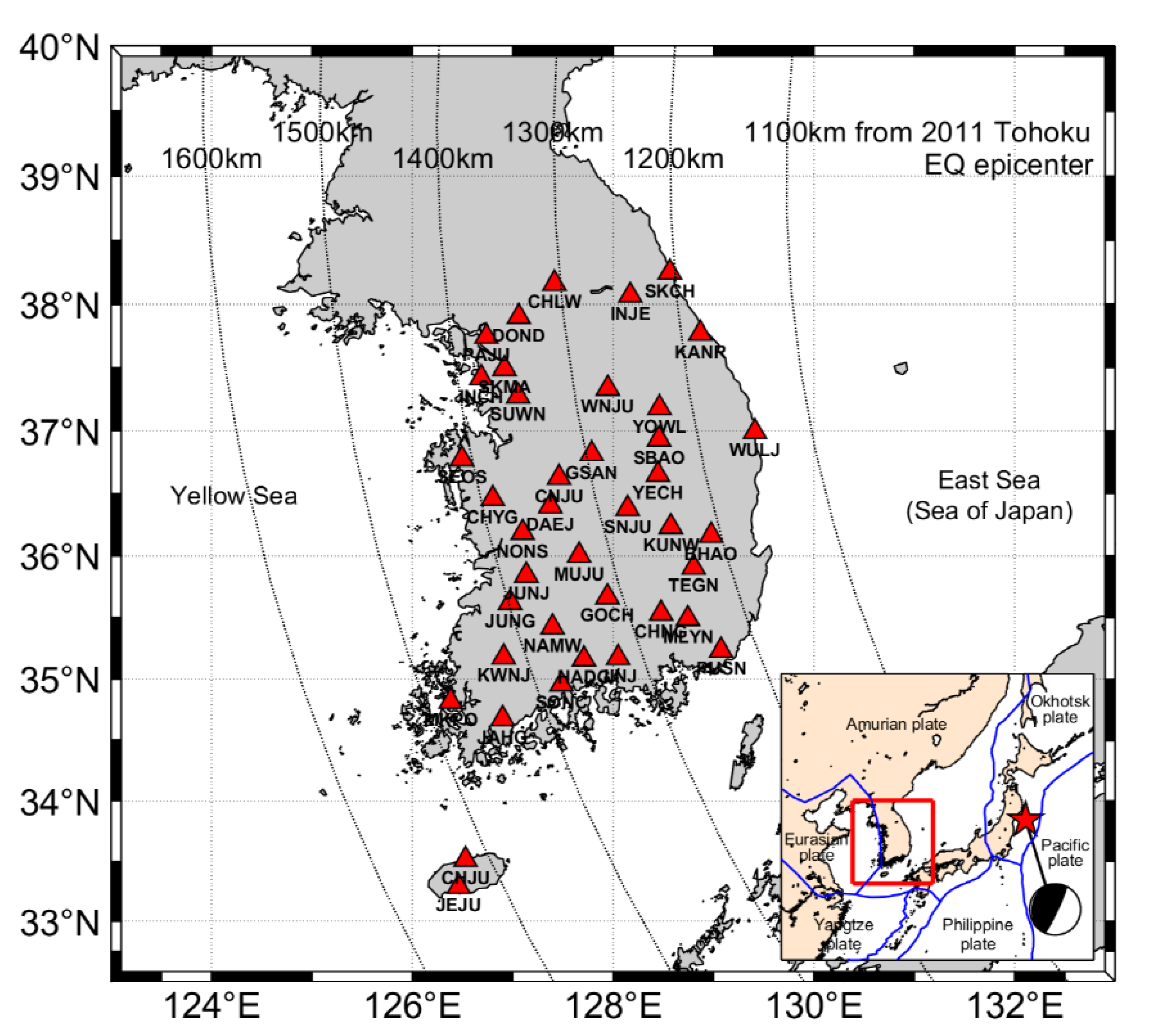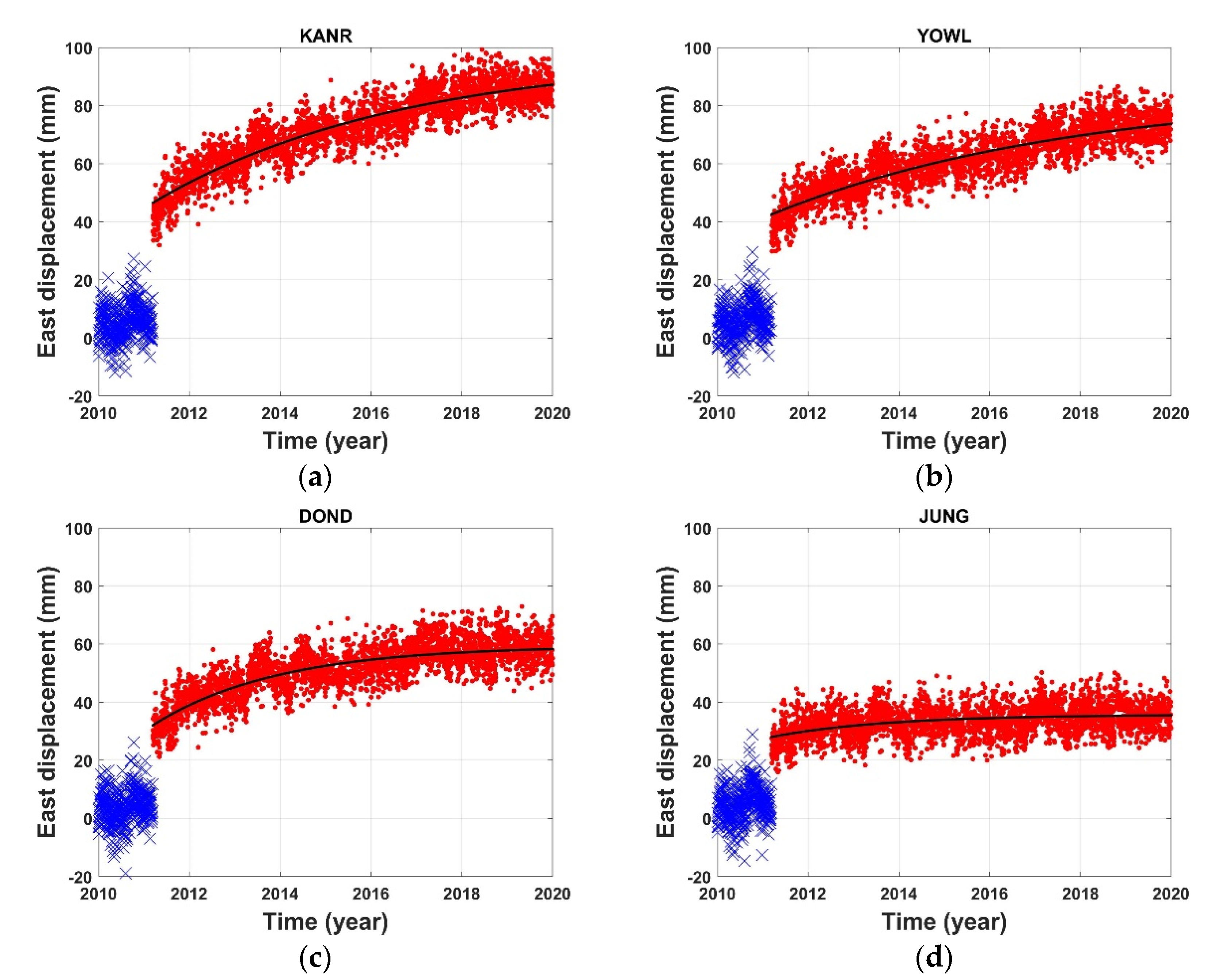Decaying Post-Seismic Deformation Observed on the Korean Peninsula Following the 2011 Tohoku-Oki Earthquake
Abstract
:1. Introduction
2. Data and Methodology
2.1. GNSS Data
2.2. Methodology
3. Results
3.1. Changes in Average Velocity Vector
3.2. Co-Seismic Displacement with Epicentral Distance
3.3. Variation of Velocity Magnitude with Epicentral Distance
3.4. Variation of Velocity Direction with Epicentral Distance
3.5. Post-Seismic Deformation
4. Discussion
5. Conclusions
Supplementary Materials
Author Contributions
Funding
Data Availability Statement
Acknowledgments
Conflicts of Interest
References
- Ergintav, S.; Burgmann, R.; McClusky, S.; Cakmak, R.; Reilinger, R.; Lenk, O.; Barka, A.; Ozener, H. Postseismic deformation near the Izmit earthquake (17 August 1999, M 7.5) rupture zone. Bull. Seismol. Soc. Am. 2002, 92, 194–207. [Google Scholar] [CrossRef]
- Hashimoto, M.; Choosakul, N.; Hashizume, M.; Takemoto, S.; Takiguchi, H.; Fukuda, Y.; Fujimori, K. Crustal deformations associated with the great Sumatra-Andaman earthquake deduced from continuous GPS observation. Earth Planets Space 2006, 58, 127–139. [Google Scholar] [CrossRef] [Green Version]
- Moreno, M.; Rosenau, M.; Oncken, O. 2010 Maule earthquake slip correlates with pre-seismic locking of Andean subduction zone. Nature 2010, 467, 198–202. [Google Scholar] [CrossRef]
- Ozawa, S.; Nishimura, T.; Suito, H.; Kobayashi, T.; Tobita, M.; Imakiire, T. Coseismic and post-seismic slip of the 2011 magnitude-9 Tohoku-Oki earthquake. Nature 2011, 475, 373–376. [Google Scholar] [CrossRef]
- Hayes, G.P. Rapid source characterization of the 2011 Mw 9.0 off the Pacific coast of Tohoku Earthquake. Earth Planets Space 2011, 63, 529–534. [Google Scholar] [CrossRef] [Green Version]
- Nettles, M.; Ekström, G.; Koss, H.C. Centroid-moment-tensor analysis of the 2011 off the Pacific coast of Tohoku Earthquake and its larger foreshocks and aftershocks. Earth Planets Space 2011, 63, 519–523. [Google Scholar] [CrossRef] [Green Version]
- Tobita, M. Combined logarithmic and exponential function model for fitting post-seismic GNSS time series after 2011 Tohoku-Oki earthquake. Earth Planets Space 2016, 68, 41. [Google Scholar] [CrossRef] [Green Version]
- Nishimura, T. Pre-, co-, and post-seismic deformation of the 2011 Tohoku-Oki earthquake and its implication to a paradox in short-term and long-term deformation. J. Disaster Res. 2014, 9, 294–302. [Google Scholar] [CrossRef]
- Yamagiwa, S.; Miyazaki, S.; Hirahara, K.; Fukahata, Y. Afterslip and viscoelastic relaxation following the 2011 Tohoku-Oki earthquake (Mw9.0) inferred from inland GPS and seafloor GPS/Acoustic data. Geophys. Res. Lett. 2015, 42, 66–73. [Google Scholar] [CrossRef] [Green Version]
- Hamdy, A.M.; Park, P.H.; Lim, H.C. Horizontal deformation in South Korea from permanent GPS network data, 2000–2003. Earth Planets Space 2005, 57, 77–82. [Google Scholar] [CrossRef] [Green Version]
- Houng, S.E.; Hong, T.K. Probabilistic analysis of the Korean historical earthquake records. Bull. Seismol. Soc. Am. 2013, 103, 2782–2796. [Google Scholar] [CrossRef]
- Jin, S.; Park, P.H. Strain accumulation in South Korea inferred from GPS measurements. Earth Planets Space 2006, 58, 529–534. [Google Scholar] [CrossRef] [Green Version]
- Cho, J.M.; Yun, H.S.; Lee, M.R. Improvement of GPS relative positioning accuracy by using crustal deformation model in the Korean Peninsula. J. Korean Soc. Surv. Geod. Photogramm. Cartogr. 2011, 29, 237–247. [Google Scholar] [CrossRef]
- Korea Meteorological Administration. 2020 Seismological Annual Report; KMA: Seoul, Korea, 2021. [Google Scholar]
- Baek, J.; Shin, Y.H.; Na, S.H.; Shestakov, N.V.; Park, P.H.; Cho, S. Coseismic and post-seismic crustal deformations of the Korean Peninsula caused by the 2011 Mw 9.0 Tohoku earthquake, Japan, from global positioning system data. Terra Nova 2012, 24, 295–300. [Google Scholar] [CrossRef]
- Ha, J.; Park, K.D.; Won, J.; Heo, M.B. Investigations into co-seismic deformation and strain in South Korea following the 2011 Tohoku-Oki earthquake using GPS CORS data. KSCE J. Civ. Eng. 2014, 18, 634–638. [Google Scholar] [CrossRef]
- Shao, Z.; Zhan, W.; Zhang, L.; Xu, J. Analysis of the far-field co-seismic and post-seismic responses caused by the 2011 MW 9.0 Tohoku-Oki earthquake. Pure Appl. Geophys. 2016, 173, 411–424. [Google Scholar] [CrossRef] [Green Version]
- Zhao, B.; Wang, W.; Yang, S.; Peng, M.; Qiao, X.; Du, R.; Nie, Z. Far field deformation analysis after the Mw9.0 Tohoku earthquake constrained by cGPS data. J. Seismol. 2012, 16, 305–313. [Google Scholar] [CrossRef]
- Hong, T.K.; Lee, J.; Houng, S.E. Long-term evolution of intraplate seismicity in stress shadows after a megathrust. Phys. Earth Planet Inter. 2015, 245, 59–70. [Google Scholar] [CrossRef]
- Kim, S.; Ree, J.H.; Yoon, H.S.; Choi, B.K.; Park, P.H. Crustal deformation of South Korea after the Tohoku-Oki earthquake: Deformation heterogeneity and seismic activity. Tectonics 2018, 37, 2389–2403. [Google Scholar] [CrossRef]
- Kim, D.; Park, K.D.; Ha, J.; Sohn, D.H.; Won, J. Geodetic analysis of post-seismic crustal deformations occurring in South Korea due to the Tohoku-Oki earthquake. KSCE J. Civ. Eng. 2016, 20, 2885–2892. [Google Scholar] [CrossRef]
- Dach, R.; Lutz, S.; Walser, P.; Fridez, P. Bernese GNSS Software Version 5.2. User Manual; Astronomical Institute, University of Bern: Bern, Switzerland, 2015. [Google Scholar]
- Blewitt, G.; Lavallée, D. Effect of annual signals on geodetic velocity. J. Geophys. Res. Solid Earth 2002, 107, ETG 9-1–ETG 9-11. [Google Scholar] [CrossRef] [Green Version]
- Draper, N.R.; Smith, H. Applied Regression Analysis, 3rd ed.; Wiley-Interscience: New York, NY, USA, 1998; pp. 34–38. [Google Scholar]
- Wang, M.; Li, Q.; Wang, F.; Zhang, R.; Wang, Y.Z.; Shi, H.B.; Zhang, P.Z.; Shen, Z.K. Far-field co-seismic displacements associated with the 2011 Tohoku-oki earthquake in Japan observed by Global Positioning System. Chin. Sci. Bull. 2011, 56, 2419–2424. [Google Scholar] [CrossRef] [Green Version]
- Shestakov, N.V.; Takahashi, H.; Ohzono, M.; Prytkov, A.S.; Bykov, V.G.; Gerasimenko, M.D.; Luneva, M.N.; Gerasimov, G.N.; Kolomiets, A.G.; Bormotov, V.A.; et al. Analysis of the far-field crustal displacements caused by the 2011 Great Tohoku earthquake inferred from continuous GPS observations. Tectonophysics 2012, 524, 76–86. [Google Scholar] [CrossRef]
- Savage, J.C.; Prescott, W.H. Asthenosphere readjustment and the earthquake cycle. J. Geophys. Res. Solid Earth 1978, 83, 3369–3376. [Google Scholar] [CrossRef]
- Kreemer, C.; Blewitt, G.; Maerten, F. Co- and post-seismic deformation of the 28 March 2005 Nias Mw 8.7 earthquake from continuous GPS data. Geophys. Res. Lett. 2006, 33, L07307. [Google Scholar] [CrossRef] [Green Version]
- Hong, T.K.; Park, S.; Houng, S.E. Seismotectonic properties and zonation of the far-eastern Eurasian plate around the Korean peninsula. Pure Appl. Geophys. 2016, 173, 1175–1195. [Google Scholar] [CrossRef]
- Tormann, T.; Enescu, B.; Woessner, J.; Wiemer, S. Randomness of megathrust earthquakes implied by rapid stress recovery after the Japan earthquake. Nature Geosci. 2015, 8, 152–158. [Google Scholar] [CrossRef]
- Suito, H. Importance of rheological heterogeneity for interpreting viscoelastic relaxation caused by the 2011 Tohoku-Oki earthquake. Earth Planets Space 2017, 69, 21. [Google Scholar] [CrossRef] [Green Version]
- Tanaka, Y.; Okuno, J.; Okubo, S. A new method for the computation of global viscoelastic post-seismic deformation in a realistic earth model (II)-horizontal displacement. Geophys. J. Int. 2007, 170, 1031–1052. [Google Scholar] [CrossRef] [Green Version]
- Sun, T.; Wang, K.; Iinuma, T.; Hino, R.; He, J.; Fujimoto, H.; Kido, M.; Osada, Y.; Miura, S.; Ohta, Y.; et al. Prevalence of viscoelastic relaxation after the 2011 Tohoku-oki earthquake. Nature 2014, 514, 84–87. [Google Scholar] [CrossRef]
- Pollitz, F.F. Lithosphere and shallow asthenosphere rheology from observations of post-earthquake relaxation. Phys. Earth Planet. Inter. 2019, 293, 106271. [Google Scholar] [CrossRef]
- Ansari, K.; Bae, T.S. Contemporary deformation and strain analysis in South Korea based on long-term (2000–2018) GNSS measurements. Int. J. Earth Sci. 2020, 109, 391–405. [Google Scholar] [CrossRef]






| Stage | Pre-Seismic Deformation | Co-seismic Deformation 1 | Post-Seismic Stage 1 | Post-Seismic Stage 2 | Post-Seismic Stage 3 |
|---|---|---|---|---|---|
| Period | 1 January 2005 – 31 December 2010 | 4 March 2011 – 18 March 2011 | 12 March 2011 – 31 December 2013 | 1 January 2014 – 31 December 2016 | 1 January 2017 – 31 December 2019 |
| Average magnitude (mm/year) | 29.9 ± 1.3 | 23.2 ± 5.3 | 36.4 ± 1.6 | 32.4 ± 1.1 | 31.1 ± 0.9 |
| Average direction (degree) | 119.0 ± 1.4 | 84.4 ± 4.0 | 106.1 ± 1.8 | 110.7 ± 1.7 | 114.7 ± 1.7 |
| Crustal Area | Thin Area (‘A’) | Thick Area (‘B’) | ||
|---|---|---|---|---|
| Stage | Avg. Direction | Diff. Direction | Avg. Direction | Diff. Direction |
| Pre-seismic (‘R’) | 120.2 | 0.0 | 117.8 | 0.0 |
| Co-seismic | 88.9 | −31.3 | 82.3 | −35.5 |
| Post-seismic 1 | 107.1 | −13.1 | 106.0 | −11.8 |
| Post-seismic 2 | 111.7 | −8.5 | 111.2 | −6.6 |
| Post-seismic 3 | 115.4 | −4.8 | 114.7 | −3.1 |
| Crustal Area | Thin Area (‘A’) | Thick Area (‘B’) |
|---|---|---|
| Average relaxation completeness (%) | 85.3 ± 13.1 | 92.7 ± 7.0 |
Publisher’s Note: MDPI stays neutral with regard to jurisdictional claims in published maps and institutional affiliations. |
© 2021 by the authors. Licensee MDPI, Basel, Switzerland. This article is an open access article distributed under the terms and conditions of the Creative Commons Attribution (CC BY) license (https://creativecommons.org/licenses/by/4.0/).
Share and Cite
Sohn, D.-H.; Choi, B.-K.; Kim, S.; Park, S.-C.; Lee, W.-J.; Park, P.-H. Decaying Post-Seismic Deformation Observed on the Korean Peninsula Following the 2011 Tohoku-Oki Earthquake. Sensors 2021, 21, 4493. https://doi.org/10.3390/s21134493
Sohn D-H, Choi B-K, Kim S, Park S-C, Lee W-J, Park P-H. Decaying Post-Seismic Deformation Observed on the Korean Peninsula Following the 2011 Tohoku-Oki Earthquake. Sensors. 2021; 21(13):4493. https://doi.org/10.3390/s21134493
Chicago/Turabian StyleSohn, Dong-Hyo, Byung-Kyu Choi, Sungshil Kim, Sun-Cheon Park, Won-Jin Lee, and Pil-Ho Park. 2021. "Decaying Post-Seismic Deformation Observed on the Korean Peninsula Following the 2011 Tohoku-Oki Earthquake" Sensors 21, no. 13: 4493. https://doi.org/10.3390/s21134493
APA StyleSohn, D.-H., Choi, B.-K., Kim, S., Park, S.-C., Lee, W.-J., & Park, P.-H. (2021). Decaying Post-Seismic Deformation Observed on the Korean Peninsula Following the 2011 Tohoku-Oki Earthquake. Sensors, 21(13), 4493. https://doi.org/10.3390/s21134493






